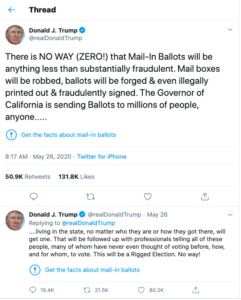As a longtime journalist and former newsroom leader at a tech platform now teaching media literacy to millions, this Twitter-Trump battle over “fact-checking” has all my worlds colliding.
And break out the popcorn ‘cause it’s about to get really interesting …
 The Washington Post reports that President Donald Trump will probably sign an executive order, possibly today, that could be a major hit to tech giants Google, Facebook and Twitter. Trump seems mad because Twitter slapped a link on two of his tweets regarding mail-in ballots and voter fraud in an attempt to “fact-check” what he was saying.
The Washington Post reports that President Donald Trump will probably sign an executive order, possibly today, that could be a major hit to tech giants Google, Facebook and Twitter. Trump seems mad because Twitter slapped a link on two of his tweets regarding mail-in ballots and voter fraud in an attempt to “fact-check” what he was saying.
The links took users to a new Twitter Moment of sorts with lots of fact-checks and reporting on the general subject. So … not quite a straight fact-check (people should really stop calling it that, to be honest).
I have a lot to stay on this subject but I will cut to the chase with my best advice for both Twitter and other platforms. And, hey, I even crafted a mini roadmap — the winning combo in my opinion — of three strategies that platforms like Twitter should focus on to combat misinformation and disinformation:
- Algorithms designed to help slow the spread of dis/misinformation, like circuit-breakers during stock market crashes
- Fact-checking programs and working with third-party, independent fact-checking organizations, like the verified signatories of the International Fact-Checking Network (disclosure, MediaWise is a verified signatory). Start with fact-checking the accuracy of content put out by influencers and accounts with large followings.
- Media literacy education programs for users, with programs like MediaWise
Going back to Twitter’s first stab with the labels on Trump’s tweet for a second — providing people context and more information always leads to good things when you’re dealing with misinformation and disinformation online if you do it in a nonpartisan, unbiased manner. That part is crucial. You’ll lose half of America’s trust in the information if it isn’t presented in a sincerely, unquestionably unbiased fashion. Even if you get criticism, you have to make the effort, and keep trying.
Do these kinds of labels work? Facebook’s fact-checking program is the most thought-out and robust (MediaWise, the project I manage at The Poynter Institute, is not yet a part of it). Accordingly, there are two studies on the impact of Facebook fact-checking labels I would suggest checking out: This one says they are effective and this one says they also have unintended, negative consequences.
There is a lot of talk about scale regarding fact-checking labels. It’s all very manual, like most good journalism. That creates a big conflict for the core goals of most social platforms — scale, scale, scale, as fast as you can. It’s a race for followers and social territory … major 19th-century gold rush vibes — it always reminds me of that.
Fact-checking and reporting work really doesn’t scale well on a 1:1 basis when you value each piece of unreliable, inaccurate or flat-out false information equally. I don’t think the answer to the rapid spread of viral disinformation and misinformation is fact-checking every piece of content on any platform. However, there are some actions that platforms can take right now that would have a significant impact to improve their online communities and slow the spread of misinformation pretty drastically.
Twitter and other platforms should not be afraid to moderate the content put out by influencers with millions of followers. Tweets and other content shared by these accounts are the fastest and most scalable way to spread misinformation and disinformation.
Well I never really thought I’d find myself tweeting about @realDonaldTrump‘s tweets being labeled by @twitter but here we are and here’s my take as someone who teaches media literacy to millions of Americans… (THREAD – 1/12)
— Katy Byron (@KABGreek) May 27, 2020
The flip side is that moderating the content posted by those accounts is one of the quickest and most efficient ways to support an online community and ecosystem that is discussing and sharing reliable and accurate information.
MediaWise and Poynter actually offer media literacy training for influencers. We teach them how to use fact-checking that journalists use to do their jobs so that they can make sure the information they put out to their millions of followers is factual, accurate and reliable so they are not spreading misinformation to their fans.
We also work with influencers to help promote media literacy skills, folks like best-selling author John Green and influencers Tyler Oakley (7.1 million subscribers on YouTube) and Ingrid Nilsen (3.6 million subscribers on YouTube). We put together a PSA video just a few months ago teaching fact-checking skills to the masses in an effort to slow the spread of misinformation, featuring these folks and others like Peter Hamby and Savannah Sellers of Snapchat fame and many others. It’s been viewed 10 million times across platforms.
One recent study of the spread of coronavirus misinformation by the Reuters Institute found “top-down misinformation from politicians, celebrities, and other prominent public figures made up just 20% of the claims in our sample but accounted for 69% of total social media engagement.” Translation: One tweet has a big impact.
President Trump’s Twitter account is among the top 10 most-followed accounts on the platform with 80.3 million followers (President Obama is No. 1with 117.7 million). Trump has 15 million more Twitter followers than Kim Kardashian.
Accounts with large followings should be held to a higher standard because the risk is so high if they share misleading and potentially dangerous information that could impact someone’s health and also chip away and further damage the stability of our democracy.
People are reading misleading information online and acting on it — putting themselves and others at risk. It’s dangerous and getting worse with conspiracy theories and more disinformation campaigns reaching the mainstream.
President Trump does not like to be told what to do or his tweets to be meddled with. I’m very interested to see where this goes and if this is a change in strategy that Twitter will stick to.
I do think it’s a step in the right direction and I hope more influential accounts on the platform will be labeled in a similar manner.
I know many fact-checking organizations, including my team at MediaWise, would be happy to work with Twitter for a stronger fact-checking system on the platform. My colleagues at the International Fact-Checking Network are standing by and waiting for Twitter to call to set up a proper fact-checking program like other platforms have done, like Facebook.
Fact-checking is one piece of this puzzle but I do feel strongly that media literacy programs for the users of these platforms are also helpful and will move the needle, which is exactly what we are doing with the MediaWise project. We have reached more than 14 million Americans since our program began in 2018, teaching people in-person and online critical digital literacy skills.
To recap, I think the secret sauce here is: algorithms for slowing the spread of mis/disinformation, fact-checking programs and media literacy education. I hope Twitter and other platforms will pursue and attack this problem from all sides, while also leaving room for innovation as bad actors continue to find new ways to spread dangerous, disinformation.
And giddy up — Election Day is about 5 months away!
Katy Byron is the editor and program manager of Poynter’s MediaWise, a nonprofit project teaching millions of Americans how to sort fact from fiction online. She is the former managing editor for news at Snapchat, overseeing the 2016 U.S. presidential election and all news Our Stories on the platform. Reach her at kbyron@poynter.org.








